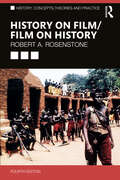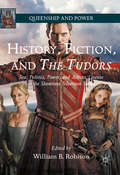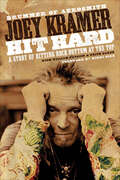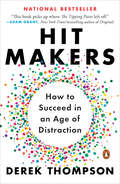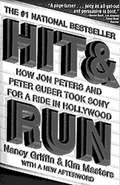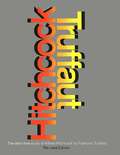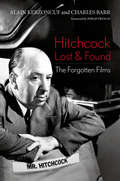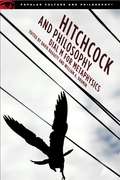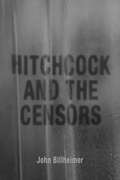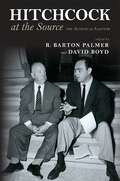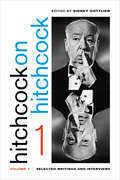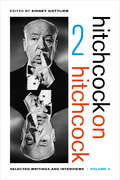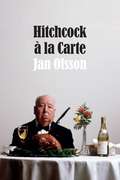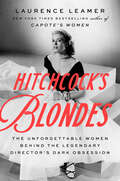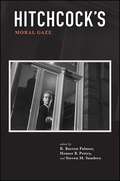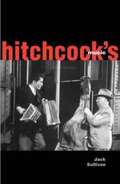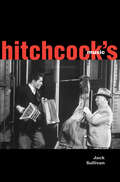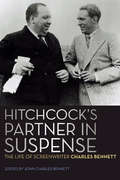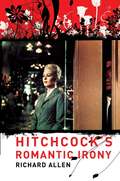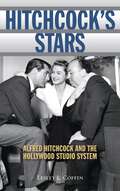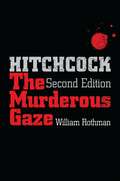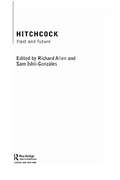- Table View
- List View
History on Film/Film on History (History: Concepts,Theories and Practice)
by Robert A. RosenstoneHistory on Film/Film on History has established itself as a classic treatise on the historical film and its role in bringing the past to life. In the fourth edition of this widely acclaimed text, Robert A. Rosenstone argues that to leave history films out of the discussion of the meaning of the past is to ignore a major means of understanding historical events. This book examines what history films convey about the past and how they convey it, demonstrating the need to learn how to read and understand this new visual world and integrating detailed analysis of films such as Schindler’s List, Glory, October, and Reds. Advocating for the dramatic feature as a legitimate way of doing history, this edition includes a new Preface and a new chapter that focuses on films produced in Latin America, Africa, the Middle East, India, and East Asia. Examining the codes and conventions of how these films tell us about the past and providing guidance on how to effectively analyse films as historical interpretations, this book is an essential introduction to the field for students of history and film.
History, Fiction, and The Tudors: Sex, Politics, Power, and Artistic License in the Showtime Television Series (Queenship and Power)
by William B. RobisonThis is the first book-length study of the award-winning historical drama The Tudors. In this volume twenty distinguished scholars separate documented history, plausible invention, and outright fantasy in a lively series of scholarly, but accessible and engaging essays. The contributors explore topics including Henry VIII, Catherine of Aragon, Anne Boleyn, his other wives and family, gender and sex, kingship, the court, religion, and entertainments.
Hit Hard: A Story of Hitting Rock Bottom at the Top
by Joey Kramer William Patrick Keith GardeIn 1997, amid Aerosmith's sold-out world tour and number one album release, word about Joey's troubles was reported in the press.Despite the advice he had received to play it down, Joey revealed in an interview his ongoing struggles with depression. The response from fans and people battling those same internal demons was overwhelming. Joey—who has been the drummer in Aerosmith since it was founded in 1970 and is the first member of the band to release his own book—now tells the complete story: the early days of the band, glamorous drug-addled events leading up to their eventual sobriety, battles within his family and among bandmates, and the explosive internal dynamics in Aerosmith that continue to unleash a fury of endless creativity. This is not just another rock 'n' roll memoir. In addition to the never-before-told Aerosmith war stories that abound in the book, Hit Hard unpacks the history of a rock star who was both fragile and tough, who after years of insane wildness became willing to accept help and finally kick a serious alcohol and drug addiction, only to find that the real terrors and hard work were still ahead. It's the story of an average kid from an average American suburb who went through physical and emotional trauma. It's about years of depression and the nervous breakdown at the height of the band's comeback success. Ultimately, Hit Hard is about how Joey recognized his confusion between love and abuse, awakening to the kind of self-acceptance and compassion that make relationships possible in the "real world" as a member of the biggest band in American history.
Hit Makers: The Science of Popularity in an Age of Distraction
by Derek Thompson“This book picks up where The Tipping Point left off." -- Adam Grant, Wharton professor and New York Times bestselling author of ORIGINALS and GIVE AND TAKENothing “goes viral.” If you think a popular movie, song, or app came out of nowhere to become a word-of-mouth success in today’s crowded media environment, you’re missing the real story. Each blockbuster has a secret history—of power, influence, dark broadcasters, and passionate cults that turn some new products into cultural phenomena. Even the most brilliant ideas wither in obscurity if they fail to connect with the right network, and the consumers that matter most aren't the early adopters, but rather their friends, followers, and imitators -- the audience of your audience. In his groundbreaking investigation, Atlantic senior editor Derek Thompson uncovers the hidden psychology of why we like what we like and reveals the economics of cultural markets that invisibly shape our lives. Shattering the sentimental myths of hit-making that dominate pop culture and business, Thompson shows quality is insufficient for success, nobody has "good taste," and some of the most popular products in history were one bad break away from utter failure. It may be a new world, but there are some enduring truths to what audiences and consumers want. People love a familiar surprise: a product that is bold, yet sneakily recognizable. Every business, every artist, every person looking to promote themselves and their work wants to know what makes some works so successful while others disappear. Hit Makers is a magical mystery tour through the last century of pop culture blockbusters and the most valuable currency of the twenty-first century—people’s attention. From the dawn of impressionist art to the future of Facebook, from small Etsy designers to the origin of Star Wars, Derek Thompson leaves no pet rock unturned to tell the fascinating story of how culture happens and why things become popular. In Hit Makers, Derek Thompson investigates: · The secret link between ESPN's sticky programming and the The Weeknd's catchy choruses · Why Facebook is the world’s most important modern newspaper · How advertising critics predicted Donald Trump · The 5th grader who accidentally launched "Rock Around the Clock," the biggest hit in rock and roll history · How Barack Obama and his speechwriters think of themselves as songwriters · How Disney conquered the world—but the future of hits belongs to savvy amateurs and individuals · The French collector who accidentally created the Impressionist canon · Quantitative evidence that the biggest music hits aren’t always the best · Why almost all Hollywood blockbusters are sequels, reboots, and adaptations · Why one year--1991--is responsible for the way pop music sounds today · Why another year --1932--created the business model of film · How data scientists proved that “going viral” is a myth · How 19th century immigration patterns explain the most heard song in the Western Hemisphere
Hit So Hard: A Memoir
by Patty SchemelA stunningly candid portrait of the Seattle grunge scene of the '90s and a memoir of an addict during the last great era of rock 'n' roll excess, by Hole drummer Patty SchemelPatty Schemel's story begins with a childhood surrounded by the AA meetings her parents hosted in the family living room. Their divorce triggered her first forays into drinking at age twelve and dovetailed with her passion for punk rock and playing the drums. Patty's struggles with her sexuality further drove her notoriously hard playing, and by the late '80s she had focused that anger, confusion, and drive into regular gigs with well-regarded bands in Tacoma, Seattle, and Olympia, Washington. She met a pre-Nirvana Kurt Cobain at a Melvins show, and less than five years later, was living with him and his wife, Hole front-woman Courtney Love, at the height of his fame and on the cusp of hers. As the platinum-selling band's new drummer, Schemel contributed memorable, driving beats to hits like "Beautiful Son," "Violet," "Doll Parts," and "Miss World." But the band was plagued by tragedy and heroin addiction, and by the time Hole went on tour in support of their ironically titled and critically-acclaimed album Live Through This in 1994, both Cobain and Hole bassist Kristen Pfaff had died at the age of 27With surprising candor and wit, Schemel intimately documents the events surrounding her dramatic exit from the band in 1998 that led to a dark descent into a life of homelessness and crime on the streets of Los Angeles, and the difficult but rewarding path to lasting sobriety after more than twenty serious attempts to get clean. Hit So Hard is a testament not only to the enduring power of the music Schemel helped create but an important document of the drug culture that threatened to destroy it.
Hit and Run
by Kim Masters Nancy GriffinHit and Run tells the improbable and often hilarious story of how two Hollywood film packagers went on a campaign to reinvent themselves as studio executives -- at Sony's expense. Veteran reporters Nancy Griffin and Kim Masters chronicle the rise of Jon Peters, a former hairdresser, seventh-grade dropout, and juvenile delinquent, and his soulless soul mate, Peter Guber -- and all the sex, drugs, and fistfights along the way. It is the story of the ultimate Hollywood con job and the standard by which every subsequent business blunder has been measured. Hit and Run delivers rock-solid business reporting liberally laced with inside gossip and outrageous scandal -- plus a new afterword bringing us up to date on the latest fallout from the Guber-Peters legacy.
Hitchcock
by Francois TruffautIconic, groundbreaking interviews of Alfred Hitchcock by film critic François Truffaut—providing insight into the cinematic method, the history of film, and one of the greatest directors of all time.In Hitchcock, film critic François Truffaut presents fifty hours of interviews with Alfred Hitchcock about the whole of his vast directorial career, from his silent movies in Great Britain to his color films in Hollywood. The result is a portrait of one of the greatest directors the world has ever known, an all-round specialist who masterminded everything, from the screenplay and the photography to the editing and the soundtrack. Hitchcock discusses the inspiration behind his films and the art of creating fear and suspense, as well as giving strikingly honest assessments of his achievements and failures, his doubts and hopes. This peek into the brain of one of cinema’s greats is a must-read for all film aficionados.
Hitchcock Blonde: A Cinematic Memoir
by Sharon DolinA heady cocktail of sex and trauma, refracted through the lens of ten of Alfred Hitchcock's iconic movies.Imagine an episodic memoir that braids together insights about Alfred Hitchcock's movies with the narrative of a woman's life: scenes of growing up in Brooklyn in the sixties and seventies as the daughter of a schizophrenic mother and a traveling salesman father, adolescent sexual traumas, and adult botched marriages and relationships— all refracted through the lens of ten of Alfred Hitchcock's iconic movies.In each chapter, the narrator—an award-winning poet—trains her idiosyncratic lens on a different film and then onto the uncanny connections they conjure up from her own life. A singular cliffhanging tale, reminiscent in style of Azar Nafisi's Reading Lolita in Tehran and Helen Macdonald's H Is for Hawk.
Hitchcock Lost & Found: The Forgotten Films (Screen Classics)
by Charles Barr Alain Kerzoncuf&“It seems there is still plenty to discover and to say about Alfred Hitchcock . . . a host of impressive new research.&” —Journal of Film Preservation Audiences worldwide know him for Psycho, The Birds, Vertigo, and other classics—but in Hitchcock Lost and Found, fans and film students alike can explore forgotten, incomplete, lost, and recovered productions from all stages of Alfred Hitchcock&’s career, including his early years in Britain. Alain Kerzoncuf and Charles Barr highlight Hitchcock&’s neglected works, including various films and television productions that supplement the critical attention already conferred on his feature films. They also explore the director&’s career during World War II, when he continued making high-profile features while also committing himself to a number of short war-effort projects on both sides of the Atlantic. Focusing on a range of forgotten but fascinating projects spanning five decades, Hitchcock Lost and Found offers a new, fuller perspective on the incomparable filmmaker&’s career and achievements. &“For the Hitchcock completist, Hitchcock Lost and Found is an essential resource.&” —Philadelphia Inquirer Includes photos and illustrations
Hitchcock and Philosophy: Dial M for Metaphysics
by David Baggett William A. DruminThe gushing shower in the Bates motel suddenly becomes a shower of blood -- The birds line up on the fence, watching and waiting -- An airplane chases Cary Grant through a cornfield -- James Stewart experiences vertigo in the church tower in San Juan Bautista. Philosophy explained through the films of Alfred Hitchcock.
Hitchcock and the Censors (Screen Classics)
by John BillheimerEdgar Award Winner: This lively account of the director&’s battles with the Code Office is &“an essential addition to any Hitchcock shelf&” (Mystery Scene Magazine). From 1934 to 1968, the Motion Picture Production Code Office controlled the content and final cut on all films made and distributed in the United States. Code officials protected sensitive ears from standard four-letter words, as well as a few five-letter words like tramp and six-letter words like cripes. They also scrubbed &“excessively lustful&” kissing from the screen and ensured that no criminal went unpunished. Thus, throughout his career, Alfred Hitchcock had to deal with a wide variety of censors attuned to the slightest suggestion of sexual innuendo, undue violence, toilet humor, religious disrespect, and all forms of indecency, real or imagined. During their review of Hitchcock&’s films, the censors demanded an average of 22.5 changes, ranging from the mundane to the mind-boggling, on each of his American films. Code reviewers dictated the ending of Rebecca, absolved Cary Grant of guilt in Suspicion, edited Cole Porter&’s lyrics in Stage Fright, decided which shades should be drawn in Rear Window, and shortened the shower scene in Psycho. In Hitchcock and the Censors, John Billheimer traces the forces that led to the Production Code and describes Hitchcock&’s interactions with code officials on a film-by-film basis as he fought to protect his creations, bargaining with code reviewers and sidestepping censorship to produce a lifetime of memorable films. Despite the often-arbitrary decisions of the code board, Hitchcock still managed to push the boundaries of sex and violence permitted in films by charming—and occasionally tricking—the censors and by swapping off bits of dialogue, plot points, and individual shots (some of which had been deliberately inserted as trading chips) to protect cherished scenes and images. By examining Hitchcock&’s priorities in dealing with the censors, this work highlights the director&’s theories of suspense as well as his magician-like touch when negotiating with code officials.
Hitchcock at the Source: The Auteur as Adapter (SUNY series, Horizons of Cinema)
by R. Barton Palmer David BoydThe adaptation of literary works to the screen has been the subject of increasing, and increasingly sophisticated, critical and scholarly attention in recent years, but most studies of the subject have continued to privilege literature over film by taking the literary sources as their starting point. Rather than examining the processes by which a particular author has been adapted into a diversity of films by different filmmakers, the contributors in Hitchcock at the Source consider the processes by which a varied range of literary sources have been transformed by one filmmaker into an impressive body of work.Throughout his career, Alfred Hitchcock transformed a variety of literary sources—novels, plays, short stories—into what is arguably the most coherent and distinctive (narratively, stylistically, and thematically) of all directorial oeuvres. After an introduction surveying the nature and diversity of Hitchcock's sources and locating the current volume in the context of theoretical work on adaptation, nineteen original essays range across the entirety of Hitchcock's career, from the silent period through to the 1970s. In addition to addressing the process of adaptation in particular films in terms of plot and character, the contributors also consider less obvious matters of tone, technique, and ideology; Hitchcock's manipulation of the conventions of literary and dramatic genres such as spy fiction and romantic comedy; and more general problems, such as Hitchcock's shift from plays to novels as his major sources in the course of the 1930s.
Hitchcock on Hitchcock, Volume 2
by Alfred Hitchcock Sidney GottliebThis second volume of Alfred Hitchcock's reflections on his life and work and the art of cinema contains material long out of print, not easily accessible, and in some cases forgotten or unknown. Edited by Sidney Gottlieb, this new collection of interviews, articles with the great director's byline, and "as-told-to" pieces provides an enlivening perspective on a career that spanned seven decades and transformed the history of cinema. In writings and interviews imbued with the same exuberance and originality that he brought to his films, Hitchcock ranges from accounts of his own life and experiences to provocative comments on filmmaking techniques and cinema in general. Wry, thoughtful, witty, and humorous--as well as brilliantly informative and insightful--this volume contains much valuable material that adds to our understanding and appreciation of a titan who decades after his death remains one of the most renowned and influential of all filmmakers. François Truffaut once said that Hitchcock "had given more thought to the potential of his art than any of his colleagues." This profound contemplation of his art is superbly captured in the pieces from all periods of Hitchcock's career gathered in this volume, which reveal fascinating details about how he envisioned and attempted to create a "pure cinema" that was entertaining, commercially successful, and artistically ambitious and innovative in an environment that did not always support this lofty goal.
Hitchcock on Hitchcock, Volume 2: Selected Writings and Interviews
by Alfred Hitchcock Sidney GottliebThis second volume of Alfred Hitchcock’s reflections on his life and work and the art of cinema contains material long out of print, not easily accessible, and in some cases forgotten or unknown. Edited by Sidney Gottlieb, this new collection of interviews, articles with the great director's byline, and "as-told-to" pieces provides an enlivening perspective on a career that spanned seven decades and transformed the history of cinema. In writings and interviews imbued with the same exuberance and originality that he brought to his films, Hitchcock ranges from accounts of his own life and experiences to provocative comments on filmmaking techniques and cinema in general. Wry, thoughtful, witty, and humorous—as well as brilliantly informative and insightful—this volume contains much valuable material that adds to our understanding and appreciation of a titan who decades after his death remains one of the most renowned and influential of all filmmakers. François Truffaut once said that Hitchcock "had given more thought to the potential of his art than any of his colleagues." This profound contemplation of his art is superbly captured in the pieces from all periods of Hitchcock’s career gathered in this volume, which reveal fascinating details about how he envisioned and attempted to create a "pure cinema" that was entertaining, commercially successful, and artistically ambitious and innovative in an environment that did not always support this lofty goal.
Hitchcock à la Carte
by Jan OlssonAlfred Hitchcock: cultural icon, master film director, storyteller, television host, foodie. And as Jan Olsson argues in Hitchcock à la Carte, he was also an expert marketer who built his personal brand around his rotund figure and well-documented table indulgencies. Focusing on Hitchcock's television series Alfred Hitchcock Presents (1955-1962) and the The Alfred Hitchcock Hour (1962-1965), Olsson asserts that the success of Hitchcock's media empire depended on his deft manipulation of bodies and the food that sustained them. Hitchcock's strategies included frequently playing up his own girth, hiring body doubles, making numerous cameos, and using food--such as a frozen leg of lamb--to deliver scores of characters to their deaths. Constructing his brand enabled Hitchcock to maintain creative control, blend himself with his genre, and make himself the multi-million-dollar franchise's principal star. Olsson shows how Hitchcock's media brand management was a unique performance model that he used to mark his creative oeuvre as strictly his own.
Hitchcock's Blondes: The Unforgettable Women Behind the Legendary Director's Dark Obsession
by Laurence LeamerBestselling author of Capote&’s Women Laurence Leamer shares an engrossing account of the enigmatic director Alfred Hitchcock that finally puts the dazzling actresses he cast in his legendary movies at the center of the story.Alfred Hitchcock was fixated—not just on the dark, twisty stories that became his hallmark, but also by the blond actresses who starred in many of his iconic movies. The director of North by Northwest, Rear Window, and other classic films didn&’t much care if they wore wigs, got their hair coloring out of a bottle, or were the rarest human specimen—a natural blonde—as long as they shone with a golden veneer on camera. The lengths he went to in order to showcase (and often manipulate) these women would become the stuff of movie legend. But the women themselves have rarely been at the center of the story, until now.In Hitchcock&’s Blondes, bestselling biographer Laurence Leamer offers an intimate journey into the lives of eight legendary actresses whose stories helped chart the course of the troubled, talented director&’s career—from his early days in the British film industry, to his triumphant American debut, to his Hollywood heyday and beyond. Through the stories of June Howard-Tripp, Madeleine Carroll, Ingrid Bergman, Grace Kelly, Janet Leigh, Kim Novak, Eva Marie Saint, and Tippi Hedren—who starred in fourteen of Hitchcock&’s most notable films and who bore the brunt of his fondness and sometimes fixation—we can finally start to see the enigmatic man himself. After all, &“his&” blondes (as he thought of them) knew the truths of his art, his obsessions and desires, as well as anyone.From the acclaimed author of Capote&’s Women comes an intimate, revealing, and thoroughly modern look at both the enduring art created by a man obsessed…and the private toll that fixation took on the women in his orbit.
Hitchcock's Moral Gaze: Hitchcock's Moral Gaze P (SUNY series, Horizons of Cinema)
by R. Barton Palmer; Homer B. Pettey; Steven M. SandersIn his essays and interviews, Alfred Hitchcock was guarded about substantive matters of morality, preferring instead to focus on discussions of technique. That has not, however, discouraged scholars and critics from trying to work out what his films imply about such moral matters as honesty, fidelity, jealousy, courage, love, and loyalty. Through discussions and analyses of such films as Strangers on a Train, Rear Window, Vertigo, North by Northwest, and Frenzy, the contributors to this book strive to throw light on the way Hitchcock depicts a moral—if not amoral or immoral—world. Drawing on perspectives from film studies, philosophy, literature, and other disciplines, they offer new and compelling interpretations of the filmmaker's moral gaze and the inflection point it provides for modern cinema.
Hitchcock's Music
by Jack SullivanFor half a century Alfred Hitchcock created films full of gripping and memorable music. Over his long career he presided over more musical styles than any director in history and ultimately changed how we think about film music. This book is the first to fully explore the essential role music played in the movies of Alfred Hitchcock. Based on extensive interviews with composers, writers, and actors, and research in rare archives, Jack Sullivan discusses how Hitchcock used music to influence the atmosphere, characterization, and even storylines of his films. Sullivan examines the director's important relationships with various composers, especially Bernard Herrmann, and tells the stories behind the musical decisions. Covering the whole of the director's career, from the early British works up to Family Plot, this engaging look at the work of Alfred Hitchcock offers new insight into his achievement and genius and changes the way we watch-and listen-to his movies.
Hitchcock's Music
by Jack Sullivan"A wonderfully coherent, comprehensive, groundbreaking, and thoroughly engaging study&” of how the director of Psycho and The Birds used music in his films (Sidney Gottlieb, editor of Hitchcock on Hitchcock). Alfred Hitchcock employed more musical styles and techniques than any film director in history, from Marlene Dietrich singing Cole Porter in Stage Fright to the revolutionary electronic soundtrack of The Birds. Many of his films—including Notorious, Rear Window, Vertigo, North by Northwest, and Psycho—are landmarks in the history of film music. Now author and musicologist Jack Sullivan presents the first in-depth study of the role music plays in Hitchcock&’s films. Based on extensive interviews with composers, writers, and actors, as well as archival research, Sullivan discusses how Hitchcock used music to influence his cinematic atmospheres, characterizations, and even storylines. Sullivan examines the director&’s relationships with various composers, especially Bernard Herrmann, and tells the stories behind some of their now-iconic musical choices. Covering the entire director&’s career, from the early British works up to Family Plot, this engaging work will change the way we watch—and listen—to Hitchcock&’s movies.
Hitchcock's Partner in Suspense: The Life of Screenwriter Charles Bennett (Screen Classics)
by Charles BennettThe colorful life and creative career of the writer behind six of Hitchcock&’s thrillers: &“An intriguing and revealing story.&” —Times Literary Supplement With a career that spanned from the silent era to the 1990s, British screenwriter Charles Bennett lived an extraordinary life. His experiences as an actor, director, playwright, film and television writer, and novelist in both England and Hollywood left him with many amusing anecdotes, opinions about his craft, and impressions of the many famous people he knew. Among other things, Bennett was a decorated WWI hero, an eminent Shakespearean actor, and an Allied spy and propagandist during WWII, but he is best remembered for his commercially and critically acclaimed collaborations with directors Sir Alfred Hitchcock and Cecil B. DeMille. The fruitful partnership with Hitchcock began after the director adapted Bennett&’s 1929 play Blackmail as the first British sound film. Their partnership produced six thrillers: The Man Who Knew Too Much, The 39 Steps, Sabotage, Secret Agent, Young and Innocent, and Foreign Correspondent. In this witty and intriguing book, Bennett discusses how their collaboration created such famous motifs as the &“wrong man accused&” device and the MacGuffin. He also takes readers behind the scenes with the Master of Suspense, offering his thoughts on the director&’s work, sense of humor, and personal life. Featuring an introduction and additional biographical material from Bennett&’s son, editor John Charles Bennett, Hitchcock&’s Partner in Suspense is a richly detailed narrative of a remarkable yet often-overlooked figure in film history.
Hitchcock's Romantic Irony
by Richard AllenIn a new interpretation of the director's work, Richard Allen argues that Hitchcock orchestrates the narrative and stylistic idioms of popular cinema to at once celebrate and subvert the ideal of romance and to forge a distinctive worldview-the amoral outlook of the romantic ironist or aesthete.
Hitchcock's Romantic Irony (Film and Culture Series)
by Richard AllenIs Hitchcock a superficial, though brilliant, entertainer or a moralist? Do his films celebrate the ideal of romantic love or subvert it? In a new interpretation of the director's work, Richard Allen argues that Hitchcock orchestrates the narrative and stylistic idioms of popular cinema to at once celebrate and subvert the ideal of romance and to forge a distinctive worldview-the amoral outlook of the romantic ironist or aesthete. He describes in detail how Hitchcock's characteristic tone is achieved through a titillating combination of suspense and black humor that subverts the moral framework of the romantic thriller, and a meticulous approach to visual style that articulates the lure of human perversity even as the ideal of romance is being deliriously affirmed. Discussing more than thirty films from the director's English and American periods, Allen explores the filmmaker's adoption of the idioms of late romanticism, his orchestration of narrative point of view and suspense, and his distinctive visual strategies of aestheticism and expressionism and surrealism.
Hitchcock's Stars: Alfred Hitchcock and the Hollywood Studio System
by Lesley L CoffinAlthough he was a visual stylist who once referred to actors as cattle, Alfred Hitchcock also had a remarkable talent for innovative and creative casting choices. The director launched the careers of several actors and completely changed the trajectory of others, many of whom created some of the most iconic screen performances in history. However, Hitchcock’s ability to fit his leading men and women into just the right parts has been a largely overlooked aspect of his filmmaking skills. In Hitchcock’s Stars: Alfred Hitchcock and the Hollywood Studio System, Lesley L. Coffin looks at how the director made the most of the actors who were at his disposal for several decades. From his first American production in 1940 to his final feature in 1976, Hitchcock’s films were examples of creative casting that strayed far from the norm during the structured Hollywood star system. Rather than examining the cinematic aspects of his work, this book explores the collaboration the director engaged in with some of the most
Hitchcock, Second Edition: The Murderous Gaze (SUNY series, Horizons of Cinema)
by William RothmanFirst published in 1982, William Rothman's Hitchcock is a classic work of film criticism. Written in an engaging style that is philosophically sophisticated yet free of jargon, and using over nine hundred images from the films to illustrate and back up its critical claims, the book follows six different Hitchcock films as they unfold, moment by moment, from first shot to last.In addition to a thoughtful new preface and the original readings of The Lodger (1927), Murder! (1930), The 39 Steps (1935), Shadow of a Doubt (1943), and Psycho (1960), this expanded edition includes a groundbreaking new chapter—now the book's longest—on Marnie (1964), Hitchcock's most heartfelt yet most controversial film. Hitchcock never tired of quoting Oscar Wilde's line, "And all men kill the thing they love." Dark moods therefore prevail in the five original chapters, culminating in the reading of Psycho, but in demonstrating how Marnie overcomes, or transcends, the murderous aspect of Hitchcock's art, this new chapter balances the scales and gives an important new dimension to the book.With exemplary precision, Hitchcock, Second Edition shows how Hitchcock films express, cinematically, serious thoughts about such matters as the nature and relationships of love, murder, sexuality, marriage, and theater—and about their own medium. In so doing, it keeps faith with the idea that Hitchcock was a master, perhaps the master, of what he called the "art of pure cinema." However, insofar as it investigates philosophically the conditions of authorship in the medium of film, it is an auteurist study unlike any other. By attending to the films themselves and to the ways we experience them, rather than allowing some theory to dictate what to say about them, the book proves the fruitfulness of an approach that is open and responsive to the ways serious films are capable of teaching us how to think seriously about them.
Hitchcock: Past and Future
by Richard Allen Sam Ishii-GonzálesThis new collection of writings on Alfred Hitchcock considers Hitchcock both in his time and as a continuing influence on filmmakers, films and film theory. The contributions, who include leading scholars such as Slavoj Zizek, Laura Mulvey, Peter Wollen, and James Naremore, discuss canonical films such as Notorious and The Birds alongside lesser-known works including Juno and the Paycock and Frenzy. Articles are grouped into four thematic sections: 'Authorship and Aesthetics' examines Hitchcock as auteur and investigates central topics in Hitchcockian aesthetics. 'French Hitchcock' looks at Hitchcock's influence on filmmakers such as Chabrol, Truffaut and Rohmer, and how film critics such as Bazin and Deleuze have engaged with Hitchcock's work. 'Poetics and Politics of Identity' explores the representation of personal and political in Hitchcock's work. The final section, 'Death and Transfiguration' addresses the manner in which the spectacle and figuration of death haunts the narrative universe of Hitchcock's films, in particular his subversive masterpiece Psycho.
